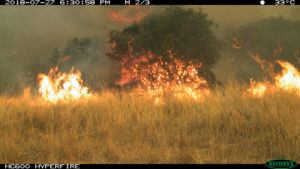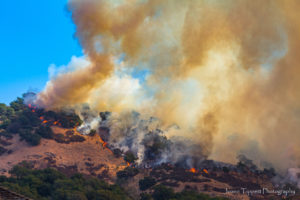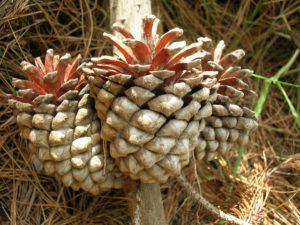Is it true that oak trees usually survive fire? And how do they do it? —Alma from Santa Rosa




Ah, oaks. Yes, Alma, healthy oaks do usually survive most fires. And thank goodness—they are among my favorite trees. Oaks are not the oldest, widest, largest, or tallest trees, but wherever they occur, they tend to dominate both in the forest and in scrubland. Oaks cover approximately one-third of California’s 33 million acres of forest. That is a lot of acorns!
The genus for oaks is Quercus, which is thought to be of Celtic origin and to mean “beautiful tree.” Agreed! The Romans in ancient Britain must have incorporated that local name into their Latin language. About 500 oak species are widespread throughout the temperate northern regions and range as far south as the equator. But there are almost no oaks in the Southern Hemisphere. We have more than 25 native oak species in California and at least eight tree species of oak in the Bay Area. The common tanoak is closely related to Quercus but falls into a different genus, Notholithocarpus.
The Spaniards noted the difference between evergreen and deciduous oaks. The former they called encinas and the latter robles. Both thrive in our Mediterranean climate. Due to our mild winters, encinas do not require complete dormancy to survive the cold and their evergreen leaves persist for years.
In addition to lightning triggering fires, Native Californians have been using fire as a management tool for thousands of years and continue to do so today. Fire clears out the undergrowth, creating improved habitat for deer, and it facilitates the gathering of acorns, which was an important food source for most of California’s Native peoples. The fires also free nutrients to move into the soil, enhancing growing conditions for the trees. Prior to European arrival and American settlement, these anthropogenic fires were usually of low intensity and fairly frequent so that there was not a huge buildup of combustible material, nor much lasting damage to the trees.
As long as fires are not intense infernos, most oaks will survive them. Oaks have very thick bark that is resistant to heat and safeguards the vital cambium cell layer that girdles a tree right under the bark. Evidence suggests that fire scars may even help protect the trees from invasive fungus. How? Some oaks develop tyloses. These are fast-growing cells that effectively block off the damaged parts and isolate them. And even if all the leaves are burned off in a spring fire, oaks can totally regrow the leaves by summer’s end. Occasionally a tree is burned completely to the ground, but with the extensive root system still intact. The next year multiple shoots emerge like a flock of woody phoenixes rising from the ashes.
Scrub jays and western gray squirrels are continually caching acorns throughout my yard in downtown Santa Rosa. Thanks to these widespread critters, there’s always a huge reservoir of potential oak trees below the surface, protected from the heat of fires. Fortunately, the critters neglect to eat many of them, so the seeds are ready and waiting to sprout when conditions are ideal.
The druids were the priestly class of the ancient Celts. Druid may have come from a Celtic word meaning the “knower of the oaks.” In the last hundred years or so there has been a resurgence of tree huggers, regardless of class. Count me as one of them, Alma! Count me in as a student and a steward of these beautiful trees.



